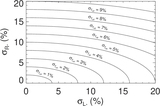Beating Stellar Systematic Error Floors Using Transit-based Densities
Abstract
It has long been understood that the light curve of a transiting planet constrains the density of its host star. That fact is routinely used to improve measurements of the stellar surface gravity and has been argued to be an independent check on the stellar mass. Here we show how the stellar density can also dramatically improve the precision of the radius and effective temperature of the star. This additional constraint is especially significant when we properly account for the 4.2% radius and 2.0% temperature systematic errors inherited from photometric zero-points, model atmospheres, interferometric calibration, and extinction. In the typical case, we can constrain stellar radii to 3% and temperatures to 1.75% with our evolutionary-model-based technique. In the best real-world cases, we can infer radii to 1.6% and temperatures to 1.1%-well below the systematic measurement floors-which can improve the precision in the planetary parameters by a factor of two. We explain in detail the mechanism that makes it possible and show a demonstration of the technique for a near-ideal system, WASP-4. We also show that both the statistical and systematic uncertainties in the parallax from Gaia DR3 are often a significant component of the uncertainty in L * and must be treated carefully. Taking advantage of our technique requires simultaneous models of the stellar evolution, bolometric flux (e.g., a stellar spectral energy distribution), and the planetary transit, while accounting for the systematic errors in each, as is done in EXOFASTv2.
- Publication:
-
The Astronomical Journal
- Pub Date:
- September 2023
- DOI:
- 10.3847/1538-3881/aceda2
- arXiv:
- arXiv:2209.14301
- Bibcode:
- 2023AJ....166..132E
- Keywords:
-
- Exoplanet astronomy;
- Planet hosting stars;
- Stellar evolutionary models;
- Spectral energy distribution;
- Measurement error model;
- Exoplanet detection methods;
- Transit photometry;
- 486;
- 1242;
- 2046;
- 2129;
- 1946;
- 489;
- 1709;
- Astrophysics - Earth and Planetary Astrophysics;
- Astrophysics - Instrumentation and Methods for Astrophysics;
- Astrophysics - Solar and Stellar Astrophysics
- E-Print:
- 18 pages, 11 figures, 5 tables, Revised to published version
